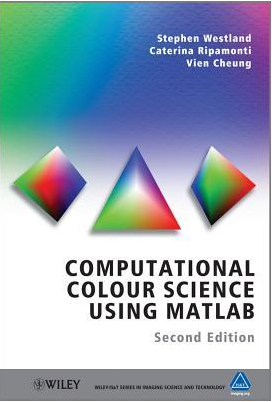
Computational Colour Science Using MATLAB : A Practical Approach
[BOOK DESCRIPTION]
Computational Colour Science Using MATLAB 2nd Edition offers a practical, problem-based approach to colour physics. The book focuses on the key issues encountered in modern colour engineering, including efficient representation of colour information, Fourier analysis of reflectance spectra and advanced colorimetric computation. Emphasis is placed on the practical applications rather than the techniques themselves, with material structured around key topics. These topics include colour calibration of visual displays, computer recipe prediction and models for colour-appearance prediction. Each topic is carefully introduced at three levels to aid student understanding. First, theoretical ideas and background information are discussed, then explanations of mathematical solutions follow and finally practical solutions are presented using MATLAB. The content includes: * A compendium of equations and numerical data required by the modern colour and imaging scientist. * Numerous examples of solutions and algorithms for a wide-range of computational problems in colour science. * Example scripts using the MATLAB programming language.This 2nd edition contains substantial new and revised material, including three innovative chapters on colour imaging, psychophysical methods, and physiological colour spaces; the MATLAB toolbox has been extended with a professional, optimized, toolbox to go alongside the current teaching toolbox; and a java toolbox has been added which will interest users who are writing web applications and/or applets or mobile phone applications. Computational Colour Science Using MATLAB 2nd Edition is an invaluable resource for students taking courses in colour science, colour chemistry and colour physics as well as technicians and researchers working in the area. In addition, it acts a useful reference for professionals and researchers working in colour dependent industries such as textiles, paints, print & electronic imaging. Review from First Edition: "...highly recommended as a concise introduction to the practicalities of colour science..." (Color Technology, 2004)
[TABLE OF CONTENTS]
Acknowledgements ix
About the Authors xi
1 Introduction 1 (12)
1.1 Preface 1 (1)
1.2 Why Base this Book on MATLABョ? 2 (2)
1.3 A Brief Review of the CIE System of 4 (9)
Colorimetry
2 Linear Algebra for Beginners 13 (6)
2.1 Some Basic Definitions 13 (1)
2.2 Solving Systems of Simultaneous Equations 14 (2)
2.3 Function Approximation 16 (3)
3 A Short Introduction to MATLABョ 19 (8)
3.1 Matrices 19 (2)
3.2 Matrix Operations 21 (2)
3.3 Solving Linear Systems 23 (2)
3.4 M-Files 25 (1)
3.5 Using Functions in MATLABョ 25 (2)
4 Computing CIE Tristimulus Values 27 (22)
4.1 Introduction 27 (1)
4.2 Colour-Matching Functions 28 (1)
4.3 Interpolation Methods 29 (9)
4.4 Extrapolation Methods 38 (1)
4.5 Correction for Spectral Bandpass 38 (1)
4.6 Tristimulus Values 39 (4)
4.7 Chromaticity Diagrams 43 (6)
5 CIELAB and Colour Difference 49 (26)
5.1 Introduction 49 (1)
5.2 CIELAB and CIELUV Colour Space 50 (10)
5.2.1 A Representation of CIELAB Using 56 (4)
MATLABョ
5.3 CIELAB Colour Difference 60 (4)
5.4 Optimised Colour-Difference Formulae 64 (11)
5.4.1 CMC (l:c) 64 (3)
5.4.2 CIE 94 67 (1)
5.4.3 CIEDE2000 68 (7)
6 Chromatic-Adaptation Transforms and Colour 75 (18)
Appearance
6.1 Introduction 75 (1)
6.2 Chromatic-Adaptation Transforms (CATs) 76 (10)
6.2.1 A Brief History of CATs 80 (1)
6.2.2 CMCCAT97 80 (3)
6.2.3 CMCCAT2000 83 (3)
6.3 Colour-Appearance Models (CAMs) 86 (7)
6.3.1 CIECAMO2 88 (5)
7 Physiological Colour Spaces 93 (26)
7.1 Introduction 93 (1)
7.2 Colour Vision 94 (2)
7.3 Cone-Excitation Space 96 (5)
7.4 MacLeod and Boynton Chromaticity Diagram 101(5)
7.5 DKL Colour Space 106(13)
8 Colour Management 119(12)
8.1 The Need for Colour Management 119(3)
8.1.1 Using MATLABョ to Create 121(1)
Representations of Gamuts
8.2 RGB Colour Spaces 122(4)
8.2.1 sRGB 123(2)
8.2.2 Adobe RGB (1998) 125(1)
8.3 The International Color Consortium 126(1)
8.4 Characterisation and Calibration 127(4)
8.4.1 Approaches to Characterisation 128(3)
9 Display Characterisation 131(12)
9.1 Introduction 131(1)
9.2 Gamma 131(1)
9.3 The GOG Model 132(1)
9.4 Device-Independent Transformation 133(1)
9.5 Characterisation Example of CRT Display 134(6)
9.6 Beyond CRT Displays 140(3)
10 Characterisation of Cameras 143(16)
10.1 Introduction 143(1)
10.2 Correction for Nonlinearity 144(2)
10.3 Correction for Lack of Spatial Uniformity 146(1)
10.4 Characterisation 146(3)
10.5 Example Characterisation of a Digital 149(10)
Camera
11 Characterisation of Printers 159(20)
11.1 Introduction 159(3)
11.1.1 Physical Models 160(1)
11.1.2 Neural Networks 161(1)
11.2 Characterisation of Half-Tone Printers 162(7)
11.2.1 Correction for Nonlinearity 162(1)
11.2.2 Neugebauer Models 163(2)
11.2.3 Example Characterisation of a 165(4)
Half-Tone Printer
11.3 Characterisation of Continuous-Tone 169(10)
Printers
11.3.1 Kubelka-Munk Models 169(3)
11.3.2 Interpolation of 3D Look-Up Tables 172(1)
11.3.3 General Linear and Nonlinear 173(1)
Transforms
11.3.4 Example Characterisation of a 173(6)
Half-Tone Printer
12 Multispectral Imaging 179(18)
12.1 Introduction 179(1)
12.2 Computational Colour Constancy and 180(2)
Linear Models
12.2.1 Example Using MATLABO 181(1)
12.3 Properties of Reflectance Spectra 182(7)
12.3.1 PCA and SVD 183(2)
12.3.2 SVD Using MATLABョ 185(4)
12.4 Application of SVD to Reflectance 189(2)
Recovery
12.5 Techniques for Multispectral Imaging 191(2)
12.5.1 Maloney-Wandell Method 191(1)
12.5.2 Imai-Berns Method 192(1)
12.5.3 Shi-Healey Method 193(1)
12.5.4 Methods Based on Maximum Smoothness 193(1)
12.5.5 Device Characterisation Revisited 193(1)
12.6 Fourier Operations on Reflectance Spectra 193(4)
A Table of White Points of Illuminants used in 197(2)
r2xyz and Other Functions
B Colour Toolbox 199(4)
B.1 Where to Find the Toolbox 199(1)
B.2 How to Install the Toolbox 199(1)
B.3 Summary of Toolbox Files 199(4)
B.3.1 Computing CIE Tristimulus Values 199(1)
B.3.2 CIELAB and Colour Difference 200(1)
B.3.3 Chromatic-Adaptation Transforms and 200(1)
Colour Appearance
B.3.4 Physiological Colour Spaces 200(1)
B.3.5 Colour Management 200(1)
B.3.6 Display Characterisation 200(1)
B.3.7 Characterisation of Cameras 201(1)
B.3.8 Characterisation of Printers 201(2)
References 203(10)
Index 213

 新书报道
新书报道